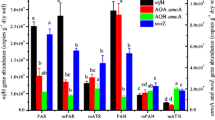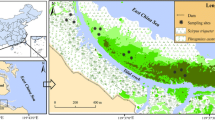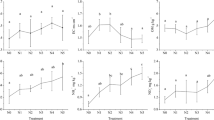Abstract
Background and aims
Dissimilatory nitrate reduction to ammonium (DNRA) plays an important role in keeping nitrate retention as a more bioavailable form (ammonium) in estuarine and intertidal environments. However, the effects of soil abiotic and biotic characteristics on DNRA in Spartina alterniflora ecotones of estuarine and intertidal wetlands remain unclear.
Methods
In this study, we used nitrogen isotope tracing and molecular approaches to investigate DNRA activity, and abiotic and biotic factors of both rhizosphere and non-rhizosphere soils in Spartina alterniflora ecotones of the Yangtze estuarine and intertidal wetlands.
Results
DNRA varied significantly throughout the sampling sites, with potential rates of 0.53–3.57 nmol N g−1 h−1. The rates of DNRA were significantly higher in rhizosphere than non-rhizosphere soils at the oligohaline sites. Salinity had more influence on DNRA activity than Spartina alterniflora at the brackish sites. Total organic carbon, nitrate, Fe (II) and sulfide were significantly correlated with DNRA rates and nrfA gene abundance. Soil substrates strongly affected DNRA activity in rhizosphere soil, while nrfA gene abundance was the predominant factor mediating DNRA activity in non-rhizosphere soil. DNRA contributed more to the total nitrate reduction at the brackish than oligohaline sites, suggesting that DNRA plays an important role in nitrate reduction in estuarine and intertidal wetlands.
Conclusions
This study suggests that soil substrates rather than nrfA gene dominate DNRA activity in estuarine and intertidal wetlands after Spartina alterniflora invasion. Our results are helpful to understand the importance of soil characteristics changes induced by the exotic plant invasion to nitrogen cycling in estuarine and intertidal wetlands.







Similar content being viewed by others
References
An S, Gardner WS (2002) Dissimilatory nitrate reduction to ammonium (DNRA) as a nitrogen link, versus denitrification as a sink in a shallow estuary (Laguna Madre/Baffin Bay, Texas). Mar Ecol Prog Ser 237(4):41–50
Bernard RJ, Mortazavi B, Kleinhuizen AA (2015) Dissimilatory nitrate reduction to ammonium (DNRA) seasonally dominates NO3 − reduction pathways in an anthropogenically impacted sub-tropical coastal lagoon. Biogeochemistry 125(1):47–64
Bonaglia S, Klawonn I, De Brabandere L, Deutsch B, Thamdrup B, Brüchert V (2016) Denitrification and DNRA at the Baltic Sea oxic–anoxic interface: substrate spectrum and kinetics. Limnol Oceanogr 61(5):1900–1915
Bonin P, Omnes P, Chalamet A (1998) Simultaneous occurrence of denitrification and nitrate ammonification in sediments of the French Mediterranean coast. Hydrobiologia 389(1–3):169–182
Brookes PC, Landman A, Pruden G, Jenkinson DS (1985) Chloroform fumigation and the release of soil nitrogen: a rapid direct extraction method to measure microbial biomass nitrogen in soil. Soil Biol Biochem 17:837–842
Canfield DE, Glazer AN, Falkowski PG (2010) The evolution and future of Earth’s nitrogen cycle. Science 330(6001):192–196
Canion A, Overholt WA, Kostka JE, Huettel M, Lavik G, Kuypers MM (2014) Temperature response of denitrification and anaerobic ammonium oxidation rates and microbial community structure in Arctic fjord sediments. Environ Microbiol 16:3331–3344
Chen X, Zhong Y (1998) Coastal erosion along the Changjiang deltaic shoreline, China: history and prospective. Estuar Coast Shelf Sci 46:733–742
Christensen PB, Rysgaard S, Sloth NP, Christensen PB, Rysgaard S, Sloth NP, Dalsgaard T, Schwaerter S (2000) Sediment mineralization, nutrient fluxes, denitrification and dissimilatory nitrate reduction to ammonium in an estuarine fjord with sea cage trout farms. Aquat Microb Ecol 257(21):73–84
Church JA, White NJ (2006) A 20th century acceleration in global sea-level rise. Geophys Res Lett 33:L01602
Craft C (2007) Freshwater input structures soil properties, vertical accretion, and nutrient accumulation of Georgia and US tidal marshes. Limnol Oceanogr 52:1220–1230
Crowe SA, Canfield DE, Mucci A, Sundby B, Maranger R (2012) Anammox, denitrification and fixed-nitrogen removal in sediments from the lower St.. Lawrence Estuary. Biogeosciences 9:4309–4321
Decleyre H, Heylen K, Van Colen C, Willems A (2015) Dissimilatory nitrogen reduction in intertidal sediments of a temperate estuary: small scale heterogeneity and novel nitrate-to-ammonium reducers. Front Microbiol 6:1124
Deegan LA, Johnson DS, Warren RS, Peterson BJ, Fleeger JW, Fagherazzi S, Wollheim WM (2012) Coastal eutrophication as a driver of salt marsh loss. Nature 490(7420):388–392
Dell’Anno A, Stefano B, Danovaro R (2002) Quantification, base composition, and fate of extracellular DNA in marine sediments. Limnol Oceanogr 47(3):899–905
Deng FY, Hou LJ, Liu M, Zheng YL, Yin GY, Li XF, Lin XB, Chen F, Gao J, Jiang XF (2015) Dissimilatory nitrate reduction processes and associated contribution to nitrogen removal in sediments of the Yangtze estuary. J Geophys Res 120:1521–1531
Domangue RJ, Mortazavi B (2018) Nitrate reduction pathways in the presence of excess nitrogen in a shallow eutrophic estuary. Environ Pollut 238:599–606
Dong LF, Smith CJ, Papaspyrou S, Stott A, Osborn AM, Nedwell DB (2009) Changes in benthic denitrification, nitrate ammonification, and anammox process rates and nitrate and nitrite reductase gene abundances along an estuarine nutrient gradient (the Colne estuary, United Kingdom). Appl Environ Microbiol 75(10):3171–3179
Dong LF, Sobey MN, Smith C, Rusmana I, Phillips W, Stott A, Osborn AM, Nedwell DB (2011) Dissimilatory reduction of nitrate to ammonium (DNRA) not denitrification or anammox dominates benthic nitrate reduction in tropical estuaries. Limnol Oceanogr 56:279–291
Dotaniya ML, Meena VD (2015) Rhizosphere effect on nutrient availability in soil and its uptake by plants: a review. P Natl A Sci India B 85(1):1–12
Du YH, Guo P, Liu JQ, Wang CY, Yang N, Jiao ZX (2014) Different types of nitrogen deposition show variable effects on the soil carbon cycle process of temperate forests. Glob Chang Biol 20(10):3222–3228
Dunn RJ, Robertson D, Teasdale PR, Waltham NJ, Welsh DT (2013) Benthic metabolism and nitrogen dynamics in an urbanized tidal creek: domination of DNRA over denitrification as a nitrate reduction pathway. Estuar Coast Shelf Sci 131:271–281
Fernandes SO, Michotey VD, Guasco S, Bonin PC, Bharathi PAL (2012) Denitrification prevails over anammox in tropical mangrove sediments (Goa, India). Mar Environ Res 74:9–19
Gao DZ, Li XF, Lin XB, Wu DM, Jin BS, Huang YP, Liu M, Chen X (2017) Soil dissimilatory nitrate reduction processes in the Spartina alterniflora invasion chronosequences of a coastal wetland of southeastern China: Dynamics and environmental implications. Plant Soil 421(1-2):383–399
Gardner WS, McCarthy MJ (2009) Nitrogen dynamics at the sediment-water interface in shallow, sub-tropical Florida bay: why denitrification efficiency may decrease with increased eutrophication. Biogeochemistry 95(2/3):185–198
Gardner WS, McCarthy MJ, An S, Sobolev D, Sell KS, Brock D (2006) Nitrogen fixation and dissimilatory nitrate reduction to ammonium (DNRA) support nitrogen dynamics in Texas estuaries. Limnol Oceanogr 51:558–568
Giblin AE, Weston NB, Banta GT, Tucker J, Hopkinson CS (2010) The effects of salinity on nitrogen losses from an oligohaline estuarine sediment. Estuar Coasts 33:1054–1068
Giblin AE, Tobias CR, Song BK, Weston N, Banta GT, Rivera-Monroy VH (2013) The importance of dissimilatory nitrate reduction to ammonium (DNRA) in the nitrogen cycle of coastal ecosystems. Oceanography 26(3):124–131
Gilbert F, Souchu P, Bianchi M, Bonin P (1997) Influence of shellfish farming activities on nitrification, nitrate reduction to ammonium and denitrification at the water-sediment interface of the Thau lagoon, France. Mar Ecol Prog Ser 151:143–153
Goeyens L, De Vries RTP, Bakker JF, Helder W (1987) An experiment on the relative importance of denitrification, nitrate reduction and ammonification in coastal marine sediment. J Sea Res 21(3):171–175
Greaver TL, Clark CM, Comptonm JE, Vallano D, Talhelm AF, Weaver CP, Band LE, Baron JS, Daavidson EA, Tague CL, Felker-quinn E, Lynch JA, Herrick JD, Liu L, Goddale CL, Novak KJ, Haeuber RA (2016) Key ecological responses to nitrogen are altered by climate change. Nat Clim Chang 6(9):836–843
Gu ZL, Li Y, Yang YF, Xia SQ, Hermanowicz SW, Alvarez-Cohen L (2018) Inhibition of anammox by sludge thermal hydrolysis and metagenomic insights. Bioresour Technol 270:46–54
Hardison AK, Algar CK, Giblin AE, Rich JJ (2015) Influence of organic carbon and nitrate loading on partitioning between dissimilatory nitrate reduction to ammonium (DNRA) and N2 production. Geochim Cosmochim Acta 164:146–160
He Y, Widney S, Ruan M, Herbert E, Li X, Craft C (2016) Accumulation of soil carbon drives denitrification potential and lab incubated gas production along a chronosequence of salt marsh development. Estuar Coast Shelf Sci 172:72–80
Henry S, Texier S, Hallet S, Bru D, Dambreville C, Chèneby D, Bizouard F, Germon JC, Philippot L (2008) Disentangling the rhizosphere effect on nitrate reducers and denitrifiers: insight into the role of root exudates. Environ Microbiol 10(11):3082–3092
Hietanen S, Kuparinen J (2008) Seasonal and short-term variation in denitrification and anammox at a coastal station on the Gulf of Finland, Baltic Sea. Hydrobiologia 596(1):67–77
Hinshaw SE, Tatariw C, Flournoy N, Kleinhuizen A, Taylor C, Sobecky PA, Mortazavi B (2017) Vegetation loss decreases salt marsh denitrification capacity: implications for marsh erosion. Environ Sci Technol 51(15):8245–8253
Hou LJ, Liu M, Carini SA, Gardner WS (2012) Transformation and fate of nitrate near the sediment–water interface of Copano Bay. Cont Shelf Res 35:86–94
Hou LJ, Zheng YL, Liu M, Gong J, Zhang XL, Yin GY, You L (2013) Anaerobic ammonium oxidation (anammox) bacterial diversity, abundance, and activity in marsh sediments of the Yangtze estuary. J Geophys Res 118:1237–1246
Jäntti H, Hietanen S (2012) The effects of hypoxia on sediment nitrogen cycling in the Baltic Sea. Ambio 41(2):161–169
Jian SY, Li JW, Chen J, Wang GS, Mayes MA, Dzantor KE, Dzantor KE, Hui DF, Luo YQ (2016) Soil extracellular enzyme activities, soil carbon and nitrogen storage under nitrogen fertilization: a meta-analysis. Soil Biol Biochem 101:32–43
Karlson K, Hulth S, Ringdahl K, Rosenberg R (2005) Experimental recolonisation of Baltic Sea reduced sediments: survival of benthic macrofauna and effects on nutrient cycling. Mar Ecol Prog Ser 294:35–49
Kessler AJ, Roberts KL, Bissett A, Cook PL (2018) Biogeochemical controls on the relative importance of denitrification and dissimilatory nitrate reduction to ammonium in estuaries. Glob Biogeochem Cycles 32:1045–1057
Kirwan ML, Megonigal JP (2013) Tidal wetland stability in the face of human impacts and sea-level rise. Nature 504:53–60
Koop-Jakobsen K, Giblin AE (2009) Anammox in tidal marsh sediments: the role of salinity, nitrogen loading, and marsh vegetation. Estuar Coasts 32(2):238–245
Koop-Jakobsen K, Giblin AE (2010) The effect of increased nitrate loading on nitrate reduction via denitrification and DNRA in salt marsh sediments. Limnol Oceanogr 55:789–802
Liu JE, Han RM, Su HR, Wu YP, Zhang LM, Richardson CJ, Wang GX (2017a) Effects of exotic Spartina alterniflora on vertical soil organic carbon distribution and storage amount in coastal salt marshes in Jiangsu, China. Ecol Eng 106:132–139
Liu X, Ruecker A, Song B, Xing J, Conner WH, Chow AT (2017b) Effects of salinity and wet–dry treatments on C and N dynamics in coastal-forested wetland soils: implications of sea level rise. Soil Biol Biochem 112:56–67
Lovley DR, Phillips EJP (1987) Rapid assay for microbially reducible ferric iron in aquatic sediments. Appl Environ Microbiol 53:1536–1540
Mao D, Luo Y, Mathieu J, Wang Q, Feng L, Mu Q, Feng CY, Alvarez PJJ (2013) Persistence of extracellular DNA in river sediment facilitates antibiotic resistance gene propagation. Environ Sci Technol 48(1):71–78
Mohan SB, Schmid M, Jetten M, Cole J (2004) Detection and widespread distribution of the nrfA gene encoding nitrite reduction to ammonia, a short circuit in the biological nitrogen cycle that competes with denitrification. FEMS Microbiol Ecol 49:433–443
Morrissey EM, Gillespie JL, Morina JC, Franklin RB (2014) Salinity affects microbial activity and soil organic matter content in tidal wetlands. Glob Chang Biol 20:1351–1362
Nielsen KM, Johnsen PJ, Bensasson D, Daffonchio D (2007) Release and persistence of extracellular DNA in the environment. Environ Biosaf Res 6(1–2):37–53
Nishio T, Koike I, Hattori A (1982) Denitrification, nitrate reduction, and oxygen consumption in coastal and estuarine sediments. Appl Environ Microbiol 43(3):648–653
Noe GB, Krauss KW, Lockaby BG, Conner WH, Hupp CR (2013) The effect of increasing salinity and forest mortality on soil nitrogen and phosphorus mineralization in tidal freshwater forested wetlands. Biogeochemistry 114:225–244
Osborne RI, Bernot MJ, Findlay SE (2015) Changes in nitrogen cycling processes along a salinity gradient in tidal wetlands of the Hudson River, New York, USA. Wetlands 35(2):323–334
Pietramellara G, Ascher J, Borgogni F, Ceccherini MT, Guerri G, Nannipieri P (2009) Extracellular DNA in soil and sediment: fate and ecological relevance. Biol Fertil Soils 45(3):219–235
Rasmussen P, Sonnenborg TO, Goncear G, Hinsby K (2013) Assessing impacts of climate change, sea level rise, and drainage canals on saltwater intrusion to coastal aquifer. Hydrol Earth Syst Sci 17:421–443
Roberts KL, Kessler AJ, Grace MR, Cook PL (2014) Increased rates of dissimilatory nitrate reduction to ammonium (DNRA) under oxic conditions in a periodically hypoxic estuary. Geochim Cosmochim Acta 133:313–324
Robertson EK, Roberts KL, Burdorf LD, Cook P, Thamdrup B (2016) Dissimilatory nitrate reduction to ammonium coupled to Fe (II) oxidation in sediments of a periodically hypoxic estuary. Limnol Oceanogr 61(1):365–381
Saeki K, Kunito T, Sakai M (2010) Effects of pH, ionic strength, and solutes on DNA adsorption by andosols. Biol Fertil Soils 46(5):531–535
Smith CJ, Nedwell DB, Dong LF, Osborn AM (2007) Diversity and abundance of nitrate reductase genes (nar G and napA), nitrite reductase genes (nirS and nrfA), and their transcripts in estuarine sediments. Appl Environ Microbiol 73:3612–3622
Smith CJ, Dong LF, Wilson J, Stott A, Osborn AM, Nedwell D (2015) Seasonal variation in denitrification and dissimilatory nitrate reduction to ammonia process rates and corresponding key functional genes along an estuarine nitrate gradient. Front Microbiol 6:542
Song GD, Liu SM, Marchant H, Kuypers MMM, Lavik G (2013) Anammox, denitrification and dissimilatory nitrate reduction to ammonium in the East China Sea sediment. Biogeosciences 10(11):6851–6864
Song BK, Lisa JA, Tobias CR (2014) Linking DNRA community structure and activity in a shallow lagoonal estuarine system. Front Microbiol 5:460
Tabatabai M (1994) Soil enzymes. In: Weaver R, Angle J, Bottomley P (eds) Methods of soil analysis, part 2: microbiological and biochemical properties. Soil Science Society of America, Madison, pp 775–833
Tang YS, Wang L, Jia JW, Li YL, Zhang WQ, Wang HL, Sun Y (2011) Response of soil microbial respiration of tidal wetlands in the Yangtze River estuary to different artificial disturbances. Ecol Eng 37:1638–1646
Thamdrup B, Dalsgaard T (2002) Production of N2 through anaerobic ammonium oxidation coupled to nitrate reduction in marine sediments. Appl Environ Microbiol 68(3):1312–1318
Van de Broek M, Vandendriessche C, Poppelmonde D, Merckx R, Temmerman S, Govers G (2018) Long-term organic carbon sequestration in tidal marsh sediments is dominated by old-aged allochthonous inputs in a macrotidal estuary. Glob Chang Biol 24:2498–2512. https://doi.org/10.1111/gcb.14089
Vance ED, Brookes PC, Jenkinson DS (1987) An extraction method for measuring soil microbial biomass C. Soil Biol Biochem 19:703–707
Xiao W, Chen X, Jing X, Zhu B (2018) A meta-analysis of soil extracellular enzyme activities in response to global change. Soil Biol Biochem 123:21–32
Yin GY, Hou LJ, Liu M, Liu ZF, Gardner WS (2014) A novel membrane inlet mass spectrometer method to measure 15NH4 + for isotope-enrichment experiments in aquatic ecosystems. Environ Sci Technol 48(16):9555–9562
Zhang YH, Ding WS, Luo JF, Donnison A (2010) Changes in soil organic carbon dynamics in an eastern Chinese coastal wetland following invasion by a C4 plant Spartina alterniflora. Soil Biol Biochem 42:1712–1720
Zhou M, Butterbach-Bahl K, Vereecken H, Brüggemann N (2017) A meta–analysis of soil salinization effects on nitrogen pools, cycles and fluxes in coastal ecosystems. Glob Chang Biol 23(3):1338–1352
Zuo P, Zhao SH, Liu CA, Wang CH, Liang YB (2012) Distribution of Spartina spp. along China's coast. Ecol Eng 40:160–166
Acknowledgments
This work was supported by the National Natural Science Foundation of China (Nos. 41725002, 41701548, 41761144062 and 41671463), the Foundation for Excellent Youth Scholar of Fujian Normal University, the Fundamental Research Funds for the Central Universities, Chinese National Key Programs for Fundamental Research and Development (Nos. 2016YFA0600904 and 2016YFE0133700), and Royal Netherlands Academy of Arts and Sciences (No. PSA-SA-E-02). It was also funded by Key Laboratory of Yangtze River Water Environment, Ministry of Education (Tongji University), China (No. YRWEF201804). We thank the two anonymous reviewers for their constructive comments on the early version of this manuscript.
Author information
Authors and Affiliations
Corresponding authors
Additional information
Responsible Editor: Sven Marhan.
Electronic supplementary material
ESM 1
(DOCX 229 kb)
Rights and permissions
About this article
Cite this article
Li, X., Gao, D., Hou, L. et al. Soil substrates rather than gene abundance dominate DNRA capacity in the Spartina alterniflora ecotones of estuarine and intertidal wetlands. Plant Soil 436, 123–140 (2019). https://doi.org/10.1007/s11104-018-03914-w
Received:
Accepted:
Published:
Issue Date:
DOI: https://doi.org/10.1007/s11104-018-03914-w




